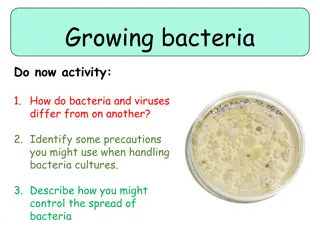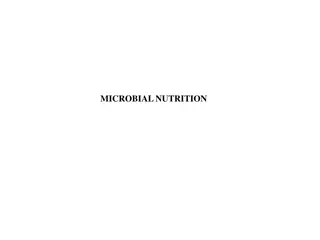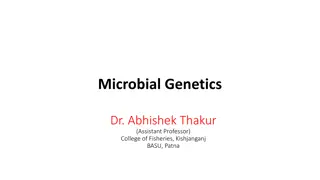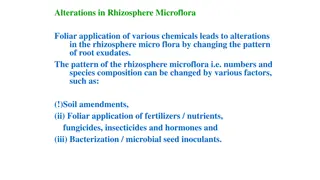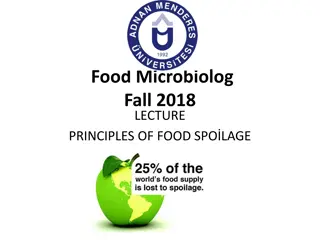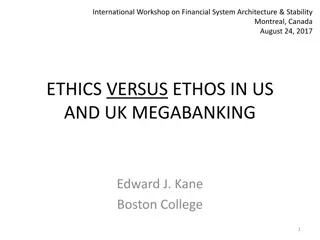Overview of Acute Gingival Diseases
Acute gingival diseases encompass various conditions such as Necrotizing Ulcerative Gingivitis, Necrotizing Ulcerative Periodontitis, Necrotizing Ulcerative Stomatitis, and others. Necrotizing Ulcerative Gingivitis (NUG) is a microbial disease primarily affecting the gingiva, characterized by necros
5 views • 67 slides
Overview of Industrial Biochemistry and Biotechnology
This course outline covers key topics in industrial biochemistry, microbiology, and biotechnology, focusing on the use of microorganisms and molecules to achieve specific goals in production processes. It delves into microbial physiology, genetics, metabolic pathways, enzymes, microbial growth, ferm
0 views • 10 slides
Understanding Applied Microbiology: Insights into Microbial Diversity and Cell Organization
Applied Microbiology focuses on harnessing the capabilities of microorganisms for the production of beneficial products like medicines, vaccines, and biotechnological advancements. This field explores the intricate interactions between prokaryotic and eukaryotic organisms, emphasizing their pivotal
0 views • 23 slides
Understanding the Rhizosphere: A Historical and Microbial Perspective
The rhizosphere, the region surrounding plant roots, harbors a diverse community of microorganisms influenced by plant roots. Historical background and microbial interactions in the rhizosphere are explored, highlighting the favorable habitat for microbial proliferation and metabolism. Various techn
1 views • 49 slides
Industrial Production of Citric Acid and Microbial Fermentation
Industrial production of citric acid has evolved from extraction processes to microbial fermentation, offering various industrial applications. Citric acid is utilized as an acidulant in food and pharmaceutical industries, a chelating agent in tanning, and a flavor enhancer in carbonated beverages.
1 views • 18 slides
Safeguarding Arrangements to Prevent Adult Abuse
This document emphasizes the importance of creating safer cultures and implementing effective safeguarding arrangements to prevent and respond to adult abuse. It covers topics such as closed cultures, organizational abuse, and the right to live free from abuse and neglect. The content highlights the
0 views • 31 slides
Understanding Bacteria Cultures and Growth: Key Concepts and Practical Tips
Scientists culture bacteria to study them effectively. Differentiating between bacteria and viruses, maintaining precautions when handling bacteria cultures, and controlling their spread are vital. Tasks like watching relevant videos, self-assessments, steps for growing useful microorganisms provide
0 views • 17 slides
Bacterial Culture Transfer Techniques and Growth Indicators
Bacterial cultures can be transferred using aseptic techniques to ensure purity. Growth indicators such as turbidity in liquid media and colonies on agar plates signify microbial growth. Proper sterilization and handling of instruments are crucial in the process. Techniques like streaking on agar pl
1 views • 4 slides
Understanding Spoilage of Canned Foods in Fish Canning Technology
Food spoilage in canned foods, especially in fish products, can be caused by microbial, chemical, and physical factors. Issues like dents or rusting on the can surface can also lead to spoilage. Microbial spoilage during canning process can result in various defects like swell, acidification, and ga
1 views • 16 slides
Understanding Microbial Nutrition and Bacterial Physiology
Microbial nutrition involves essential elements required for microbial growth and energy production. Bacterial physiology delves into the structures and functions that enable bacteria to thrive, from cell wall composition to enzyme activities. Major elements like C, O, H, N, S, and P are crucial for
2 views • 20 slides
Understanding Microbial Nutrition and Growth Factors
Microbes require carbon for metabolic activities, with organisms categorized as heterotrophs or autotrophs based on their carbon source. In addition to carbon, macronutrients like nitrogen, phosphorous, sulfur, potassium, and magnesium are crucial for cell function. Growth factors such as amino acid
0 views • 15 slides
Understanding Microbial Genetics and Mutations in Organisms
Explore the world of microbial genetics with Dr. Abhishek Thakur, an Assistant Professor specializing in Microbial Genetics at the College of Fisheries, Kishjanganj, BASU, Patna. Learn about important concepts such as strains, clones, genome, phenotype, genotype, genes, genetic recombination, and mu
0 views • 19 slides
Understanding Closed Cultures in Health and Social Care Settings
Explore the concept of closed cultures in health and social care settings, including the reasons behind their development, inherent risk factors, warning signs, and appropriate responses. Learn about the impact of the Covid-19 pandemic on closed cultures and the efforts of the Care Quality Commissio
0 views • 26 slides
Perspectives on Recreation and Physical Activities Across Cultures and Genders
Ideologies, beliefs, and world views shape how different cultures and genders approach recreation and physical activities. In Eastern cultures, martial arts and spiritual practices like yoga hold significance, while in Western cultures, sports are often viewed as a business opportunity. South Africa
0 views • 13 slides
Methods for Determination of Microbial Growth
Quantitative determination of microbial growth is crucial for various purposes, with two commonly used methods being the standard plate count and spectrophotometric measurement. The standard plate count method estimates living microbial cell density, while spectrophotometric measurement relies on tu
2 views • 6 slides
Understanding Microbial Ecology: Interactions and Associations in Ecosystems
Interactions of organisms in ecosystems play a crucial role in the functioning of microbial ecology. Dr. Abhishek Thakur explores symbiosis, mutualism, syntrophism, commensalism, predation, and parasitism, shedding light on how different organisms interact with each other and their physical environm
0 views • 9 slides
Factors Affecting Microbial Growth in Food: Intrinsic and Extrinsic Factors
In food, microbial growth is influenced by intrinsic factors like pH, water activity, nutrient content, and extrinsic factors such as environmental conditions. The pH level, moisture content, and water activity play crucial roles in determining the growth of microorganisms, with specific ranges affe
0 views • 23 slides
Mechanisms of Nutrient Uptake by Microbial Cells
Nutrient uptake by microbial cells involves various transport mechanisms such as passive diffusion, facilitated diffusion, active transport, and group translocation. These mechanisms ensure the specific acquisition of required nutrients by the cell through the selectively permeable plasma membrane.
3 views • 15 slides
Industrial Applications of Microbial Biomass Production
Microbial biomass has various industrial applications such as the production of single-cell proteins, antibiotics, ethanol, and organic acids. This biomass can serve as a valuable resource for seed cultures, silage production, biopesticides, animal fodder, and more. Yeasts like Saccharomyces cerevis
2 views • 17 slides
Understanding the Normal Microbial Flora of the Human Body
The normal microbial flora, also known as the indigenous microbiota, inhabit various areas of the human body such as the gastrointestinal tract, respiratory tract, genitourinary tract, and skin. They play a crucial role in maintaining health and can re-establish themselves when disturbed. While resi
0 views • 22 slides
Understanding Alterations in Rhizosphere Microflora Due to Chemical Applications
Chemical applications through soil amendments, foliar fertilizers, and microbial seed inoculants can lead to changes in the rhizosphere microflora composition. Factors like soil amendments with fertilizers, foliar application of chemicals, and seed treatment with bio inoculants play a role in alteri
5 views • 24 slides
Understanding Microbial Nutrition and Essential Elements
Microbial nutrition is crucial for the growth and functioning of microorganisms, requiring various elements in different quantities to construct cellular components and obtain energy. Major elements like carbon, oxygen, hydrogen, nitrogen, sulfur, phosphorus, and others play vital roles in microbial
0 views • 20 slides
Understanding Microbial Growth Phases
Microbial growth involves distinct phases such as the lag phase where cells prepare for division, followed by the exponential phase where rapid growth occurs. Factors like medium composition and nutrient availability influence the duration of these phases. The population in the exponential phase is
0 views • 21 slides
Microbiological Inspection of Mineral Water by Redox Potential Measurement
MicroTester is a validated method for rapid microbiological testing of various types of water such as mineral water and carbonated water. Real-time monitoring of microbial properties in water production is crucial for ensuring safety and quality. The energy for microbial growth comes from biological
0 views • 27 slides
Understanding Organisational Culture: Influencing Change & Organisational Cultures
Organisational culture plays a crucial role in influencing change within an organization. The key is to understand and respect the diverse ways people work and make decisions, shaped by their unique cultures. The culture of an organization guides its collective behavior and susceptibility to change.
0 views • 20 slides
Factors Affecting Microbial Growth in Foods
Moisture content and pH levels are key factors influencing the growth and survival of microorganisms in foods. The water activity (aw) of food substrates affects microbial growth, with bacteria and fungi having varying requirements. Lowering aw below optimum levels can increase the lag phase of grow
2 views • 15 slides
Optimization of Bioethanol Production from Cassava Peels Using Microbial Inoculants
This study focuses on optimizing bioethanol production from cassava peels of different cassava varieties using various microbial inoculants. Cassava, a widely cultivated food crop in tropical regions, provides an attractive source for bioethanol production due to its high yield and ease of cultivati
0 views • 27 slides
Multidimensional Optimality of Microbial Metabolism
Exploring the multidimensional optimality of microbial metabolism through metabolic network analysis, C-based flux analysis, and stoichiometric reaction modeling. The concept of Pareto optimal solutions in multi-objective optimization problems is discussed in the context of microbial metabolic pathw
0 views • 22 slides
Reassessing Scholarly and Sub-Scientific Mathematical Cultures
Scholarly and sub-scientific mathematical cultures are reevaluated through the works of Jens Hoyrup, focusing on the organized nature of sub-scientific knowledge. The distinction between theoretical and practical knowledge, applications to mathematical cultures, and misconceptions related to the sup
0 views • 53 slides
Innovative Hygienic Solution for Healthcare Facilities: Introducing Medi-ShowerTM
Multi-Shower GB has developed the award-winning Medi-Shower, a unique anti-microbial showering system designed for healthcare facilities. Featuring color-coded Medi-Flush inserts, quarterly maintenance, and continual protection from bacteria, Medi-Shower provides a comprehensive solution to address
0 views • 11 slides
Effects of Spicy Foods on Pathogenic Microbial Growth: A Study on Rosemary and Clove
Spicy foods like rosemary and clove have shown potential in inhibiting pathogenic microbial growth, which can help enhance food safety by reducing the need for chemical additives. This study explores the antimicrobial effects of these spices using microbial strains like Pseudomonas Fluorescens and S
0 views • 14 slides
Indigenous Cultures of New York: Iroquois and Algonquian Societies
Exploring the similarities and differences between the Iroquois and Algonquian cultures in New York, their settlement patterns, and the significance of nature in their societies. The Iroquois settlements were larger and featured longhouses, while the Algonquian settlements had smaller wigwams. Both
0 views • 18 slides
Advancing Microbiological Systems Through Genetic Engineering and Microbial Community Engineering
Exploring the intersection of genetic engineering and microbial community engineering to enhance electron bifurcation systems. Addressing trade-offs between synthetic biology and wildtype organisms, incorporating microbial community engineering in Synbio, and investigating CO2 metabolism in the abse
0 views • 8 slides
MicrobeDB Database Analysis for Microbial Diversity
In June 2017, data from MicrobeDB.jp was analyzed, revealing microbial diversity in various phyla and families. The study included Wilcoxon P-values and abundances of different microbial genera. The analysis indicated the presence of various bacterial and archaeal species in different environments,
0 views • 20 slides
Microbial Isolation Techniques and Methods
This content provides a detailed guide on the isolation of microbes from various environments using techniques such as sample introduction, inoculation, incubation, inspection, and identification. It includes information on the use of an incubator, materials, and methods required for microbial isola
0 views • 13 slides
Principles of Food Spoilage: Understanding Microbial and Nonmicrobial Factors
Explore the principles of food spoilage in the context of microbial and nonmicrobial influences. Topics covered include classification of foods based on stability, types of agents causing spoilage, prevention practices, and the criteria for acceptability of food. Learn about microbial growth, enzyme
0 views • 19 slides
Ethical Challenges in Megabanking and Government Regulations
Talk delves into the diminishing ethical standards in megabanking and regulatory cultures, citing the Dunning-Kruger Effect. Analysis focuses on the prevalence of unethical behaviors leading to financial crises, emphasizing solutions found closer in the UK. The model of executive cultures and the Du
0 views • 17 slides
Understanding Microbial Growth: Phases and Dynamics
Microbial growth is defined as an increase in cellular constituents leading to a rise in microorganism size or population. The growth of bacterial cells is characterized by distinct phases such as lag phase and exponential phase. During the lag phase, cells are synthesizing new components before div
0 views • 21 slides
Understanding Aquatic Microbial Groups and Their Environments
Explore the diverse world of aquatic microbial groups, their distribution in different water bodies, and their roles in ecosystems. Learn about the factors influencing microbial growth in water, the impact of eutrophication, bioremediation strategies, and the unique microbial communities found in es
0 views • 18 slides
Understanding Anti-Microbial Agents and Their Applications
Anti-microbial agents, including antiseptics, disinfectants, and germicides, play a crucial role in preventing infections and promoting public health. They can inhibit the growth of pathogenic micro-organisms on living tissues, objects, and materials. Sterilization ensures complete destruction of al
0 views • 16 slides






